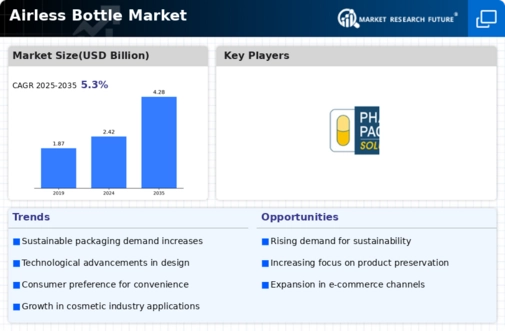Market Share
Airless Bottle Market Share Analysis
The Airless Bottle Market is experiencing rapid growth as the demand for airless packaging solutions in the cosmetics and personal care industries has increased. Market players here are adopting other market share positioning strategies to differentiate themselves in the market place. One of such strategies is product innovation. These firms have noticed that customers want effective and hygienic product dispensing, and therefore, they are investing heavily on research and development of advanced airless bottle designs. They, thus, create a new range of products that prevent air from entering the packaging hence extending shelf life of cosmetic and skin care products while minimizing waste. The aim is to offer state-of-the-art airless packaging solutions in order to stand out in the eyes of cosmetics brands while becoming pacesetters in this industry.
Cost leadership continues to be one strategic market positioning for Airless Bottle Market (ABM). As brands look for affordable premium packaging options, companies optimize production processes so as to bring down manufacturing costs. By offering competitive-priced yet high quality or useful airless bottles, these companies hope to attract a wide range of cosmetics and personal care product manufacturers. This strategy is very crucial since pricing decisions play an important role when selecting packaging alternatives for any marketer who wants to survive competition
Strategic partnerships and collaborations have been key determinants of how companies position themselves within the Airless Bottle Market (ABM). There are many different types of cosmetic companies; hence, companies involved with ABM have created various relationships with them such as alliances with cosmetic brands; Packaging designers; Manufacturing partners: etcetera. Such relationships go beyond enhancing the design and aesthetics aspects of airless bottles by making it easier for them to customize these products based on specific needs or requirements from figures like colors or logos associated with certain cosmetic businesses. For comprehensive partners who can deliver customized airless packaging solutions, there exists a need for collaborative approaches.
Geographic expansion also falls under market share positioning strategies employed by firms operating in the Airless Bottle Market (ABM). With the growth of the cosmetics industry worldwide, companies are expanding their presence strategically by establishing distribution networks and manufacturing bases in key markets. This move allows them not only to tap into emerging opportunities but also be seen as suppliers who can cater for a wide range of needs both global and local personal care brands.
Sustainability is increasingly becoming one of the major market share positioning strategies in the Airless Bottle Market (ABM). To meet the demand for environmentally friendly packaging, companies are investing in sustainable materials as well as manufacturing processes. Thereby degradation capable materials, ability to recycle and reduced environmental impact are now some of the popular factors considered when designing airless bottles. Consequently, they become green-conscious vendors hence aligning themselves with sustainability goals sought by cosmetic brands in this competitive packaging market.
Another aspect of market share positioning that is prominent in ABM is customer focus which entails customization and user-friendly features. By taking into consideration brand image requirements and user experience, these organizations have been modifying their airless bottle designs to suit specific customers’ demands. For starters, companies provide customization options such as innovative dispensing mechanisms and beautiful appearances that result into strong relationships with cosmetics brands thereby fostering loyalty from customers based on visual attractiveness as well as performability within this particular market space although high purchase price may deter others from using it at first.





Leave a Comment